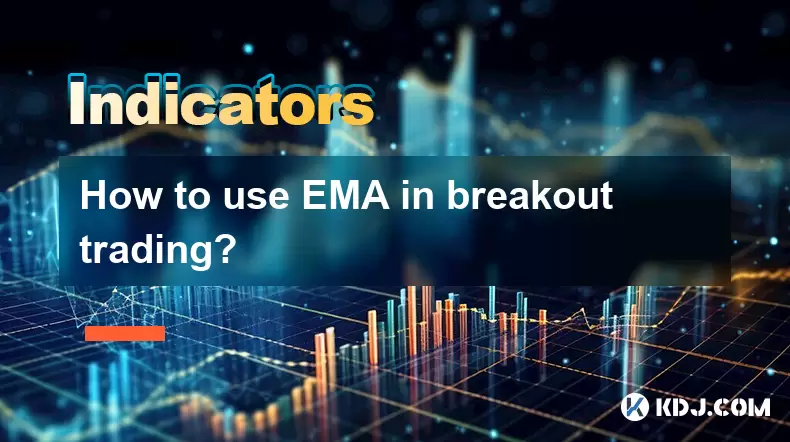-
 bitcoin
bitcoin $118548.520763 USD
3.67% -
 ethereum
ethereum $4352.564943 USD
4.79% -
 xrp
xrp $2.964058 USD
4.22% -
 tether
tether $1.000565 USD
0.05% -
 bnb
bnb $1028.372955 USD
1.46% -
 solana
solana $221.373507 USD
6.00% -
 usd-coin
usd-coin $0.999933 USD
0.02% -
 dogecoin
dogecoin $0.248633 USD
6.85% -
 tron
tron $0.341444 USD
2.38% -
 cardano
cardano $0.852946 USD
5.82% -
 hyperliquid
hyperliquid $47.869306 USD
6.15% -
 chainlink
chainlink $22.561476 USD
6.01% -
 ethena-usde
ethena-usde $1.001258 USD
0.05% -
 avalanche
avalanche $30.660000 USD
2.06% -
 stellar
stellar $0.400917 USD
9.76%
How to use EMA in breakout trading?
Use EMA in crypto breakout trading by setting up charts with 50-day, 100-day, and 200-day EMAs to identify trends and execute trades based on price crossovers.
May 22, 2025 at 08:56 pm

Breakout trading is a popular strategy among cryptocurrency traders, aiming to capitalize on price movements as they break through key levels of support or resistance. One effective tool in this strategy is the Exponential Moving Average (EMA), which helps traders identify trends and potential breakout points. This article will guide you through the process of using EMA in breakout trading within the cryptocurrency market.
Understanding EMA and Its Role in Breakout Trading
The Exponential Moving Average (EMA) is a type of moving average that places a greater weight and significance on the most recent data points. Unlike the Simple Moving Average (SMA), which assigns equal weight to all values, the EMA reacts more quickly to price changes, making it an ideal tool for identifying trends and potential breakouts.
In breakout trading, the EMA can help traders identify the direction of the trend and potential breakout levels. By plotting different EMAs on a chart, traders can see when the price breaks above or below these averages, signaling potential entry or exit points.
Setting Up Your Chart with EMAs
To use EMA in breakout trading, you'll need to set up your trading chart with the appropriate EMAs. Here's how you can do it:
- Choose Your Trading Platform: Ensure your chosen platform supports customizable indicators. Popular platforms for cryptocurrency trading include Binance, Coinbase Pro, and TradingView.
- Add EMAs to Your Chart: Navigate to the indicators section and add the EMA. You'll need to specify the period for each EMA. Common periods used in breakout trading are the 50-day EMA, 100-day EMA, and 200-day EMA.
- Customize the Appearance: Adjust the color and thickness of each EMA line for better visibility and distinction on your chart.
Identifying Breakout Points Using EMAs
Once your chart is set up with the EMAs, the next step is to identify potential breakout points. Here's how to do it:
- Watch for Crossovers: A breakout often occurs when the price crosses above or below an EMA. For instance, if the price moves above the 50-day EMA, it might signal the start of an uptrend, and vice versa for a downtrend.
- Confirm with Multiple EMAs: To increase the reliability of your breakout signals, look for crossovers across multiple EMAs. If the price breaks above the 50-day EMA and then the 100-day EMA, it could indicate a stronger bullish breakout.
- Volume Confirmation: Always check the trading volume during a potential breakout. A breakout accompanied by high volume is more likely to be sustainable.
Executing Trades Based on EMA Breakouts
With potential breakout points identified, you can now execute your trades. Here's a step-by-step guide:
- Set Entry Points: When the price breaks above an EMA, consider entering a long position. Conversely, if the price breaks below an EMA, consider a short position.
- Determine Stop Losses: Place your stop loss just below the breakout level to manage risk. For instance, if you enter a long position after a breakout above the 50-day EMA, set your stop loss just below this EMA.
- Set Take Profit Levels: Identify potential resistance levels where the price might reverse. Use these levels to set your take profit orders.
- Monitor and Adjust: Keep an eye on the market and be ready to adjust your stop loss and take profit levels as the price moves.
Using EMA in Different Time Frames
EMAs can be applied across various time frames, from short-term intraday charts to longer-term weekly charts. Here's how to use EMAs in different time frames:
- Short-Term Trading: For intraday trading, use shorter EMA periods such as the 9-day EMA and 21-day EMA. These will help you catch quick breakouts and trends within the day.
- Medium-Term Trading: For swing trading, the 50-day EMA and 100-day EMA are effective in identifying medium-term trends and breakouts.
- Long-Term Trading: For long-term investment strategies, the 200-day EMA is crucial. A breakout above this level can signal a significant bullish trend, while a break below can indicate a bearish trend.
Combining EMA with Other Indicators
While EMA is powerful on its own, combining it with other indicators can enhance your breakout trading strategy. Here are some effective combinations:
- EMA and RSI: The Relative Strength Index (RSI) can help confirm overbought or oversold conditions during a breakout. If the price breaks above the 50-day EMA and the RSI is not overbought, it might be a good entry point.
- EMA and MACD: The Moving Average Convergence Divergence (MACD) can help confirm the strength of a breakout. A bullish crossover on the MACD after a price breakout above the 100-day EMA can signal a strong uptrend.
- EMA and Bollinger Bands: Bollinger Bands can help identify volatility and potential breakout levels. A breakout above the upper Bollinger Band and the 200-day EMA can indicate a strong bullish move.
Practical Example of EMA Breakout Trading
Let's walk through a practical example of using EMA in breakout trading with Bitcoin (BTC).
- Setting Up the Chart: Add the 50-day EMA, 100-day EMA, and 200-day EMA to your Bitcoin chart on a daily time frame.
- Identifying a Breakout: Suppose the price of Bitcoin breaks above the 50-day EMA and then the 100-day EMA with high volume. This indicates a potential bullish breakout.
- Executing the Trade: Enter a long position after the price breaks above the 100-day EMA. Set your stop loss just below the 50-day EMA and your take profit at a resistance level identified from previous highs.
- Monitoring and Adjusting: As the price moves, adjust your stop loss to lock in profits and move your take profit level higher if the trend continues.
Frequently Asked Questions
Q: Can EMA be used for all cryptocurrencies?A: Yes, EMA can be applied to any cryptocurrency that has sufficient trading volume and price data. However, the effectiveness of EMA might vary depending on the liquidity and volatility of the specific cryptocurrency.
Q: How do I choose the right EMA periods for my trading strategy?A: The choice of EMA periods depends on your trading style and time frame. For short-term trading, use shorter periods like the 9-day and 21-day EMAs. For medium-term trading, the 50-day and 100-day EMAs are suitable, while for long-term trading, the 200-day EMA is commonly used.
Q: What are the risks associated with using EMA in breakout trading?A: The primary risk is false breakouts, where the price briefly moves above or below an EMA but then reverses. To mitigate this, always confirm breakouts with volume and other indicators, and use appropriate stop losses.
Q: How often should I adjust my EMA settings?A: Adjust your EMA settings based on market conditions and the performance of your trading strategy. If you find that your current EMA settings are not providing reliable signals, consider experimenting with different periods or time frames.
Disclaimer:info@kdj.com
The information provided is not trading advice. kdj.com does not assume any responsibility for any investments made based on the information provided in this article. Cryptocurrencies are highly volatile and it is highly recommended that you invest with caution after thorough research!
If you believe that the content used on this website infringes your copyright, please contact us immediately (info@kdj.com) and we will delete it promptly.
- BlockDAG, DOGE, HYPE Sponsorship: Crypto Trends Shaping 2025
- 2025-10-01 00:25:13
- Deutsche Börse and Circle: A StableCoin Adoption Powerhouse in Europe
- 2025-10-01 00:25:13
- BlockDAG's Presale Buzz: Is It the Crypto to Watch in October 2025?
- 2025-10-01 00:30:13
- Bitcoin, Crypto, and IQ: When Genius Meets Digital Gold?
- 2025-10-01 00:30:13
- Stablecoins, American Innovation, and Wallet Tokens: The Next Frontier
- 2025-10-01 00:35:12
- NBU, Coins, and Crypto in Ukraine: A New Yorker's Take
- 2025-10-01 00:45:14
Related knowledge

What is a tower bottom candlestick pattern? Does it have a high success rate?
Sep 22,2025 at 07:18am
Tower Bottom Candlestick Pattern Explained1. The tower bottom candlestick pattern is a reversal formation that typically appears at the end of a downt...

What is a black hole pattern in the MACD indicator? Is it a cause for concern?
Sep 21,2025 at 06:54pm
Bitcoin's Role in Decentralized Finance1. Bitcoin remains the cornerstone of decentralized finance, serving as a benchmark for value and security acro...

How can I use the psychological line (PSY) to determine market sentiment?
Sep 17,2025 at 02:19pm
Understanding the Psychological Line (PSY) in Cryptocurrency TradingThe Psychological Line, commonly referred to as PSY, is a momentum oscillator used...

How can I determine if a double top pattern has officially formed?
Sep 21,2025 at 03:18am
Understanding the Structure of a Double Top Pattern1. A double top pattern consists of two distinct peaks that reach approximately the same price leve...

What is the Golden Valley pattern on the moving average? Is it better than the Silver Valley pattern?
Sep 21,2025 at 02:54pm
Understanding the Golden Valley Pattern in Moving Averages1. The Golden Valley pattern is a technical formation observed in cryptocurrency price chart...

What does a death cross of the RSI in the strong zone (above 50) mean?
Sep 17,2025 at 10:54pm
Understanding the Death Cross in RSI Context1. The term 'death cross' is traditionally associated with moving averages, where a short-term average cro...

What is a tower bottom candlestick pattern? Does it have a high success rate?
Sep 22,2025 at 07:18am
Tower Bottom Candlestick Pattern Explained1. The tower bottom candlestick pattern is a reversal formation that typically appears at the end of a downt...

What is a black hole pattern in the MACD indicator? Is it a cause for concern?
Sep 21,2025 at 06:54pm
Bitcoin's Role in Decentralized Finance1. Bitcoin remains the cornerstone of decentralized finance, serving as a benchmark for value and security acro...

How can I use the psychological line (PSY) to determine market sentiment?
Sep 17,2025 at 02:19pm
Understanding the Psychological Line (PSY) in Cryptocurrency TradingThe Psychological Line, commonly referred to as PSY, is a momentum oscillator used...

How can I determine if a double top pattern has officially formed?
Sep 21,2025 at 03:18am
Understanding the Structure of a Double Top Pattern1. A double top pattern consists of two distinct peaks that reach approximately the same price leve...

What is the Golden Valley pattern on the moving average? Is it better than the Silver Valley pattern?
Sep 21,2025 at 02:54pm
Understanding the Golden Valley Pattern in Moving Averages1. The Golden Valley pattern is a technical formation observed in cryptocurrency price chart...

What does a death cross of the RSI in the strong zone (above 50) mean?
Sep 17,2025 at 10:54pm
Understanding the Death Cross in RSI Context1. The term 'death cross' is traditionally associated with moving averages, where a short-term average cro...
See all articles










































































